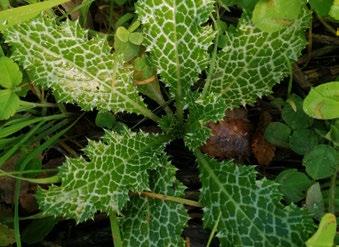
4 minute read
MEET LINDA BEE
FORAGING FOR EDIBLES IN MARCH Make Use of Edible Plants & Weeds in Cyprus
Are you aware of how many edible plants and weeds grow naturally here in Cyprus? If you are one for being out and about in nature, you may be surprised to hear that many of the plants you come across carry many health and medicinal benefits for all types of conditions and illnesses. This month we spoke to Linda Bee, a plant specialist and beekeeper from The Netherlands, now living in Cyprus.
Advertisement
“I have always been interested in medicinal plants, and edible plants have had my interest since I first saw my mother add fresh nettles to my soup, to help me get rid of anaemia as a child. Later in life, I studied herbs and became a beekeeper offering lectures on ‘the flowers and the bees’. Upon arriving in Cyprus, I signed up for the P3A Foraging Group lead by Steve Catchpole in Polemi. Being outside and foraging in nature is not only good fun but also very healing and restorative for the body and mind. March is an excellent time for foraging because of the process of blooming changing the chemistry of the entire plant.” Linda Bee
EDIBLE PLANTS & WEEDS IN CYPRUS IN MARCH
Wild Marigolds (Kitrini Margarita) Wild Marigolds have a pleasant aroma, and the crushed flowers are used in ointments to heal wounds. The flowers are much smaller than the cultivated ones and open only when the sun shines. Harvesting is best on bright and sunny mornings.
Milk Thistle (Gaidourangatho) Milk thistle has striking white veins on its broad leaves. Legend has it that the Virgin Mary spilt milk from her glass onto the leaves of the Milk Thistle plant. It is used to stimulate lactation in women, heal liver damage and aid depression. Make sure you cut off the prickly edges before using it!

Fennel (Marathos) Fennel is one of my favourites because of its rich and distinctive anise taste. Fennel offers excellent benefits for the digestive system and helps against baby cramps when the breastfeeding mother eats/drinks it. It is primarely used by Cypriots in the traditional Pumpkin Pie and to give an aromatic flavour to the preparation of dried figs.
Nettles (Tsouknitha) Nettles in Cyprus have thicker leaves and are much hairier than the ones in Northern Europe. The sting may be harsher, but it does not last as long. Wear gloves! Don’t be afraid to use Nettles in your food or tea because the hot water takes away the sting immediately. Nettles are excellent for help in purifying the blood and are full of Iron, Vitamin A and C. They are also considered beneficial for blood circulation and detoxing the liver.
Dandelion (Pikralida) Don’t mistake a dandelion for a weed! It is highly nutritious, for humanity and bees, and has strong detoxifying qualities, especially the bitter-tasting roots. The flowers can be used to make a joyful syrup. The leaves are great in salads, work as a digestive and also work to reduce excessive body fat.

Wild Asparagus (Agrelli, Sparangi) Always bring a stick when foraging, especially when you go for Wild Asparagus. Asparagus protect themselves from being eaten by hiding really well in stone walls and shrubs. With a stick, you can trace back the stems to the soil where you find the sprouts, while at the same time keeping away snakes that wake up from hibernation in March.
Milk Thistle
Other edible plants and weeds include Luvana, Shepherd’s Purse, Henbit Deadnettle and Black Mustard Spice.

Fennel

POINTS TO REMEMBER: • All edible plants can be used to create healthy salads, herbal teas, pasta sauces, omelettes and pancakes. • Always use young leaves and clean the plants before usage. • When using raw, let them soak in water for 3 minutes with a pinch of salt (in case of soil) or a dash of vinegar. • You can find all these plants along the roadside, in uncultivated areas and wasteland. • Never consume a plant unless you are very sure what it is. • If you are a beginner, always take the advice of an expert.
The fun of foraging is the search, like finding a piece for a jigsaw amid all the greens. When you forage in agricultural land and meadows, make sure not to harvest from fields sprayed with pesticides. This is easy to detect by the overall yellow sight and by the way the droopy leaves hang from the plant.
Literature: Savvides, L. 2000. Edible Wild Plants of the Cyprus Flora, Sinclair, V. 1998 (reprint). The Floral Charm of Cyprus. Hertfordshire: Interworld Publications, Hadjikyriakou G.N (text) & Christophides M. (paintings) 2008. By the Side of the Road. Nicosia: Bank of Cyprus Cultural Foundation.









